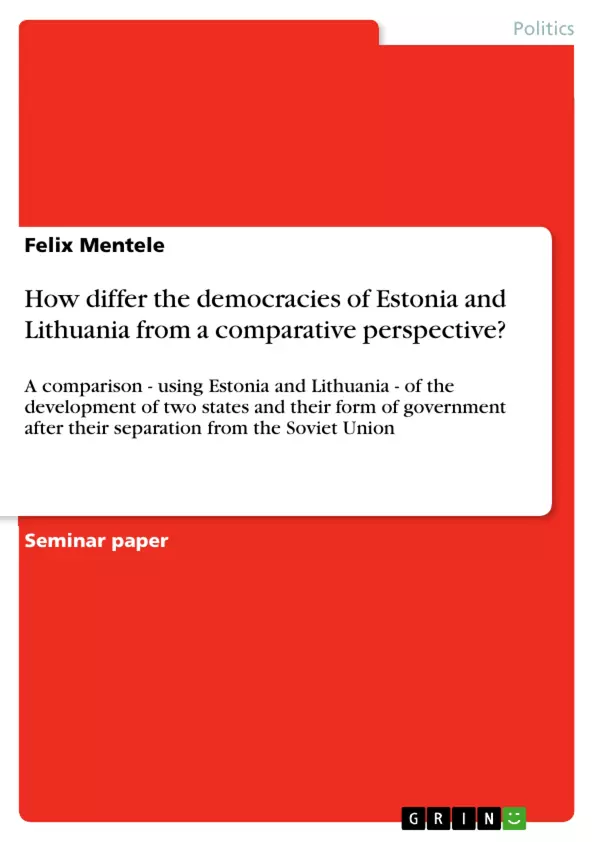The term paper aims to explain the varying level of democracy in the two post-Soviet countries Estonia and Lithuania.
The topic is relevant due to the proximity of these countries to Russia, as well as the current trend of democratic backsliding across Central and Eastern Europe. The two particular cases were selected due to their overall similarity, as the paper pursues the most-similar system design.
The theoretical framework first conceptualizes democracy, the dependent variable of the study. It proceeds to introduce some factors which might theoretically be responsible for the differing level of democracy in Central and Eastern Europe in general.
The research design chapter describes the most-similar system design, introduces the index of democracy to be used in the empirical analysis, and lays out the steps of the empirical analysis.
The empirical analysis first delivers the scores of the democracy index for the two countries, before evaluating the possible effect of various factors. The analysis finds that the decisive factors are political and not economic.
Inhaltsverzeichnis (Table of Contents)
- Introduction
- Literature review
- Theoretical approach
- Methodology
- Empirical Analysis
- Discussion
- Conclusion
- Bibliography
Zielsetzung und Themenschwerpunkte (Objectives and Key Themes)
This term paper aims to investigate and compare the development of democracy in Estonia and Lithuania after their separation from the Soviet Union, focusing on key variables that differentiate their respective democratic trajectories. This comparative analysis examines how these two Baltic States, with their shared history and proximity to Russia, have approached Western ideals of democracy and achieved varying levels of integration into the European Union.
- The development of democratic institutions and processes in Estonia and Lithuania
- The influence of historical factors and the Soviet legacy on democratic transition
- The role of the European Union and its Copenhagen criteria in fostering democracy
- The impact of economic and social factors on democratic stability
- The implications of Estonia and Lithuania's democratic experiences for other post-Soviet states
Zusammenfassung der Kapitel (Chapter Summaries)
- Introduction: This chapter introduces the research question and provides context for the analysis, highlighting the significance of comparing Estonia and Lithuania as case studies of democratic transition in the post-Soviet era. It establishes the broader theoretical framework and outlines the paper's structure.
- Literature review: This chapter reviews existing literature on the collapse of the Soviet Union, democratization in Central and Eastern Europe, and specifically, the development of democratic institutions and practices in Estonia and Lithuania. It discusses key research findings and identifies relevant sources for the study.
- Theoretical approach: This chapter delves into the theoretical framework underpinning the research, focusing on democracy theory, the Copenhagen criteria for EU membership, and the concept of democratic stability in the context of post-Soviet transitions.
- Methodology: This chapter outlines the methodology employed in the study, including the research design, data collection methods, and analytical approaches used to compare the democratic trajectories of Estonia and Lithuania.
- Empirical Analysis: This chapter presents the empirical findings of the research, examining the key variables and indicators that contribute to understanding the differences in democratic development between Estonia and Lithuania. The analysis draws upon quantitative and qualitative data to support the findings.
- Discussion: This chapter discusses the implications of the empirical findings, interpreting the differences in democratic development between Estonia and Lithuania, and exploring potential explanations for these variations.
Schlüsselwörter (Keywords)
This paper examines the development of democracy in Estonia and Lithuania, focusing on key concepts such as democratic transition, post-Soviet states, European Union integration, Copenhagen criteria, democratic stability, economic and social factors, historical legacy, and comparative analysis. It explores how these factors contribute to understanding the differences in their democratic trajectories and the implications for other countries undergoing similar transitions.
- Quote paper
- Felix Mentele (Author), 2020, How differ the democracies of Estonia and Lithuania from a comparative perspective?, Munich, GRIN Verlag, https://www.grin.com/document/1045058



